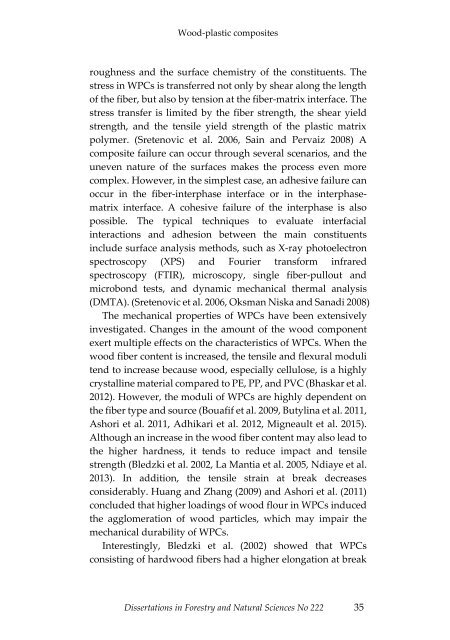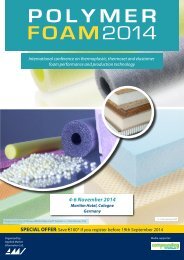Dissertations in Forestry and Natural Sciences
24lYKFN
24lYKFN
Create successful ePaper yourself
Turn your PDF publications into a flip-book with our unique Google optimized e-Paper software.
Wood-plastic composites<br />
roughness <strong>and</strong> the surface chemistry of the constituents. The<br />
stress <strong>in</strong> WPCs is transferred not only by shear along the length<br />
of the fiber, but also by tension at the fiber-matrix <strong>in</strong>terface. The<br />
stress transfer is limited by the fiber strength, the shear yield<br />
strength, <strong>and</strong> the tensile yield strength of the plastic matrix<br />
polymer. (Sretenovic et al. 2006, Sa<strong>in</strong> <strong>and</strong> Pervaiz 2008) A<br />
composite failure can occur through several scenarios, <strong>and</strong> the<br />
uneven nature of the surfaces makes the process even more<br />
complex. However, <strong>in</strong> the simplest case, an adhesive failure can<br />
occur <strong>in</strong> the fiber-<strong>in</strong>terphase <strong>in</strong>terface or <strong>in</strong> the <strong>in</strong>terphasematrix<br />
<strong>in</strong>terface. A cohesive failure of the <strong>in</strong>terphase is also<br />
possible. The typical techniques to evaluate <strong>in</strong>terfacial<br />
<strong>in</strong>teractions <strong>and</strong> adhesion between the ma<strong>in</strong> constituents<br />
<strong>in</strong>clude surface analysis methods, such as X-ray photoelectron<br />
spectroscopy (XPS) <strong>and</strong> Fourier transform <strong>in</strong>frared<br />
spectroscopy (FTIR), microscopy, s<strong>in</strong>gle fiber-pullout <strong>and</strong><br />
microbond tests, <strong>and</strong> dynamic mechanical thermal analysis<br />
(DMTA). (Sretenovic et al. 2006, Oksman Niska <strong>and</strong> Sanadi 2008)<br />
The mechanical properties of WPCs have been extensively<br />
<strong>in</strong>vestigated. Changes <strong>in</strong> the amount of the wood component<br />
exert multiple effects on the characteristics of WPCs. When the<br />
wood fiber content is <strong>in</strong>creased, the tensile <strong>and</strong> flexural moduli<br />
tend to <strong>in</strong>crease because wood, especially cellulose, is a highly<br />
crystall<strong>in</strong>e material compared to PE, PP, <strong>and</strong> PVC (Bhaskar et al.<br />
2012). However, the moduli of WPCs are highly dependent on<br />
the fiber type <strong>and</strong> source (Bouafif et al. 2009, Butyl<strong>in</strong>a et al. 2011,<br />
Ashori et al. 2011, Adhikari et al. 2012, Migneault et al. 2015).<br />
Although an <strong>in</strong>crease <strong>in</strong> the wood fiber content may also lead to<br />
the higher hardness, it tends to reduce impact <strong>and</strong> tensile<br />
strength (Bledzki et al. 2002, La Mantia et al. 2005, Ndiaye et al.<br />
2013). In addition, the tensile stra<strong>in</strong> at break decreases<br />
considerably. Huang <strong>and</strong> Zhang (2009) <strong>and</strong> Ashori et al. (2011)<br />
concluded that higher load<strong>in</strong>gs of wood flour <strong>in</strong> WPCs <strong>in</strong>duced<br />
the agglomeration of wood particles, which may impair the<br />
mechanical durability of WPCs.<br />
Interest<strong>in</strong>gly, Bledzki et al. (2002) showed that WPCs<br />
consist<strong>in</strong>g of hardwood fibers had a higher elongation at break<br />
<strong>Dissertations</strong> <strong>in</strong> <strong>Forestry</strong> <strong>and</strong> <strong>Natural</strong> <strong>Sciences</strong> No 222 35



